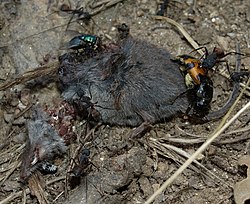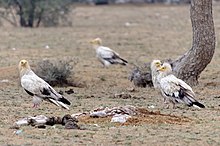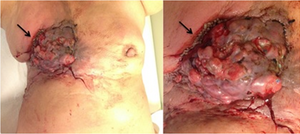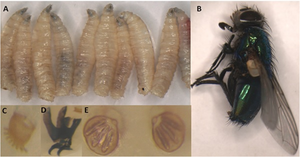
Necrophages are organisms that obtain nutrients by consuming decomposing dead animal biomass, such as the muscle and soft tissue of carcasses and corpses. The term derives from Greek nekros, meaning 'dead', and phagein, meaning 'to eat'. Many hundreds of necrophagous species have been identified including invertebrates in the insect, malacostracan and gastropod classes and vertebrates such as vultures, hyenas, quolls and wolves.
Necrophagous insects are important in forensic science as the presence of some species (e.g. Calliphora vomitoria) in a body, coupled with information on their development stage (e.g. egg, larva, pupa), can yield information on time of death. Information on the insect species present can also be used as evidence that a body has been moved, and analysis of insect tissue can be used as evidence that drugs or other substances were in the body.
Invertebrates
Diptera
Members of the order Diptera, such as Nematocera, Calliphoridae, Sacrophagidae, and Muscidae, as well as semi-aquatic Diptera larvae, such as Simuliidae and Chironomidae, are the most common necrophages within the Animalia kingdom. Diptera species play a critical role in forensic entomology, as they tend to colonize the human body during the early floating phase of decomposition. The flies utilize the submerged corpse as a source of food as well as an attachment site. Notably, Diptera do not specifically colonize and feed on human carcasses. Diptera species, such as Musca domestica and Chloroprocta idioidea have been observed feeding on the carcasses of other mammalian carcasses, including the Mona monkey, the European rabbit, and the Giant cane rat, as well as fish carrion. The carcass' appeal is characterized by the putridness of the odour it emits; thus, the olfactory system of Diptera species plays a role in their food selectivity. In addition, the diversity and abundance of Diptera species vary both spatially and temporally. Necrophagous Diptera, such as Calliphora vicina, tend to be concentrated in urban areas and rare in more rural areas. However, some researchers oppose this notion and claim anthropogenic impacts are negligible regarding species richness. Temporally, the necrophagous Diptera are observed in higher abundances in the summer season than the winter season. The presence of specific Diptera abundance depends on the reproductive strategy retained by the family. For example, Calliphoridae have a high larval growth rate accompanied by a low survival rate, while Sarcophagidae produce little offspring with longer life cycles. The latter is said to benefit necrophagous Diptera in particular environments, such as forests and urbanized areas.
Hymenoptera
Particular Hymenoptera, such as members of the genus Trigona are obligate necrophages. Trigona worker bees play a similar role to the Apis genus; however, along with collecting pollen, nectar, and plant resins, Trigona workers also collect carrion from vertebrate carcasses. Although pollen is associated with higher energy value, dead tissue from vertebrate carcasses is preferred by Trigona bees because it is biochemically easier to extract energy from. The dead animal tissue and muscle replace pollen as the primary protein source. Cerumen pots are utilized by some Trigona species, such as T. necrophaga, as vesicles to store foodstuff. The foodstuff of T. necrophaga consists of both honey and carrion from vertebrate carcasses. Ultimately, the stored food is utilized by developing larvae and the worker bee itself as a source of nutrition and energy. Due to the rapid decomposition of carrion, especially in warm temperatures, the bees must efficiently metabolize the carrion to avoid rotten carrion in their cerumen pots.Trigona hypogea communicate the presence of a valuable carcass through olfactory signals. The bees create an odour trail between their nest and the prospective animal carcass; thus, the bees recruit the other nest members to respond and exploit the corpse's resources rapidly. Additionally, interspecific competition is observed in Trigona hypogea bees. The bees are observed to defend their colonized food item, including but not limited to a monkey, lizard, fish, or snake carcass, from competing necrophages, such as flies.
Coleoptera

Coleoptera, specifically Cleridae, Dytiscidae, Scarabaeidae, Hydrophilidae, are common necrophages and, like Diptera, tend to play critical roles in forensic entomology. Dytiscidae are aquatic in both the adult and larval stages of their life cycles; thus, the beetles play a role in colonizing submerged human corpses. Through colonization, the beetles assume a predacious role and feed on the dead tissue of the body. Dytiscidae species, such as Rhantus validus, retain mouthparts characterized by curved, asymmetrical and highly sclerotized mandibles. The mouthparts have a cutting edge and a groove that allows the insect to release digestive enzymes into its prey item and maxillae with sharp teeth. Researchers matched the post-mortem skin injuries of a human corpse to the mouthparts of such beetles and, in doing so, revealed necrophagous activity in the dermis and epidermis. Notably, the necrophagy elicited by Rhantus validus also created microhabitats for other, smaller necrophages by allowing access to freshly dead internal tissue. Necrophagy amongst Coleoptera is not confined to mammalian carcasses. Necrophagous activity has been observed in Scarabaeidae species, such as Scybalocanthon nigriceps and on the fresh carcasses of Tree frogs. The beetle is observed to use its front legs and clypeus to shape the frog carrion into pellets for eventual consumption. In aquatic environments, Dytiscidae and Hydrophilidae species have also been observed to engage in the necrophagous activity of Granular toads. Necrophagous beetles like Coprophanaeus ensifer may also build their burrows near carcasses for easier transportation of pieces of carrion into the burrow.
Gastropoda
Nassariidae, such as Nassarius festivus and Nassarius clarus scavenge upon dead or decaying animal matter in the intertidal zone of eulittoral soft shores. On a sandflat in Monkey Mia in the World Heritage Site of Shark Bay, Australia, Nassarius clarus acts as a necrophage and feeds on the carrion of fishes and bivalves. In the presence of carrion, the animal's proboscis performs a search reaction followed by a quick onset of feeding. When faced with a competitor, such as a hermit crab, at the site of the carrion, the Nassarius clarus attack the competition to defend their meal. Nassarius clarus are attracted to fish and bivalve carrion to a distance of 26 miles and have a heightened interest in areas where the sand has been disturbed; thus, indicating the potential presence of organic detritus or damaged fauna.
Vertebrates

Accipitrimorphae
Necrophagy has been observed in members of the clade Accipitrimorphae, including the Egyptian vulture, Eurasian griffon, cinereous vulture, black vulture, turkey vulture, and the king vulture. The birds, mainly vultures, have been noted to feed on the fleshy tissue and muscle of mammalian vertebrates, such as cows, pigs, and rabbits, as well as other birds. Additionally, the preyed upon carcasses have been recorded to be naturally deceased or the product of anthropogenic events, such as roadkill; thus, the means of prey retrieval may differ depending on spatial circumstances, such as the urbanization of a particular area. Notably, anthropogenic impacts have had adverse impacts on the biological parameters of necrophagous birds, specifically in the territory of the Azerbaijan Republic. The adverse effects include but are not limited to shortage of food, shootings of birds and nests, and removal of nestlings from nests. Due to the advances of cattle-breeding, involving indoor breeding and the utilization of dead cattle, many necrophagous birds, such as the Eurasian griffon, are losing access to nutritionally valuable cow carcasses. Therefore, the feeding ecology and the interspecific relationships of necrophagous birds are both directly and indirectly impacted by humans.
Role in Forensic Entomology


Necrophagous Diptera and Coleoptera play vital roles in the applications of forensic entomology. Necrophagy is critical to forensic scientists because of the production of post-mortem changes on human corpses through myiasis. For example, a forensic medical examiner must determine which soft tissues have been removed as a result of necrophages post-mortem. Entomological data can be utilized in homicide cases to determine the post-mortem interval (PMI) and localize the crime. This information is indicated by the time it takes the necrophage larvae to reach a particular developmental stage; thus, the life cycle of the necrophage provides detail regarding the interval between the initial myiasis and the discovery of the corpse. Notably, the colonization of a human corpse by Diptera necrophages is positively correlated with particular injuries, such as gunshot wounds and lacerations. The nature of these injuries provides higher levels of accessibility for the necrophagous Diptera and allows them to colonize the corpse rapidly. Seasonal changes, particularly temperature changes, significantly affect the abundance and degree of myiasis of necrophages. The increase or decrease in temperature that accompanies seasonal changes determines the rate of development retained by necrophages, particularly Diptera. High temperatures lead to an exponential increase in the rate of development in Diptera. Therefore, the body temperature of a corpse is of utmost importance to necrophages, as they prefer fresh internal tissue and sexually thrive in warm environments. However, the corpse's temperature may have adverse effects on the determination of the post-mortem interval (PMI) because the necrophages' development may be rapid due to body's temperature and not the passage of time.
In addition, Coleoptera provide valuable information to forensic entomologists. Specifically, in the later stages of decomposition, Dermestidae and Cleridae have been recorded to colonize human corpses and provide insight regarding the post-mortem interval (PMI). However, researchers note that there are spatial differences that affect the latency of necrophagous Coleoptera presence.
See also
References
- ^ Getz, Wayne M. (February 2011). "Biomass transformation webs provide a unified approach to consumer-resource modelling". Ecology Letters. 14 (2): 113–124. Bibcode:2011EcolL..14..113G. doi:10.1111/j.1461-0248.2010.01566.x. PMC 3032891. PMID 21199247.
- ^ Keh, B (January 1985). "Scope and Applications of Forensic Entomology". Annual Review of Entomology. 30 (1): 137–154. doi:10.1146/annurev.en.30.010185.001033. PMID 3882048.
- ^ Gilliam, Martha; Buchmann, Stephen L.; Lorenz, Brenda J.; Roubik, David W. (March 1985). "Microbiology of the Larval Provisions of the Stingless Bee, Trigona hypogea, an Obligate Necrophage". Biotropica. 17 (1): 28. Bibcode:1985Biotr..17...28G. doi:10.2307/2388374. JSTOR 2388374.
- ^ Cushnie, T. P.; Luang-In, V.; Sexton, D.W. (2025). "Necrophages and necrophiles: a review of their antibacterial defenses and biotechnological potential". Critical Reviews in Biotechnology: 1–18. doi:10.1080/07388551.2024.2389175. PMID 39198023.
- ^ Cheung, S. G.; Lam, S. (5 November 1999). "Effect of food availability on egg production and packaging in the intertidal scavenging gastropod Nassarius festivus". Marine Biology. 135 (2): 281–287. Bibcode:1999MarBi.135..281C. doi:10.1007/s002270050625. S2CID 85201716.
- ^ Allen JC, Anderson GS, Benecke M, et al. (2001). Byrd JH, Castner JL (eds.). Forensic Entomology: The Utility of Arthropods in Legal Investigations. London: CRC Press. pp. 43–80, 143–176, 263–286, 331–340. ISBN 978-0849381201.
- Harvey, M. L.; Gasz, N.E.; Voss, S.C. (2016). "Entomology-based methods for estimation of postmortem interval". Research and Reports in Forensic Medical Science. 6: 1–9. doi:10.2147/RRFMS.S68867.
- Charabidze, D.; Gosselin, M.; Hedouin, V. (2017). "Use of necrophagous insects as evidence of cadaver relocation: myth or reality?". PeerJ. 5: e3506. doi:10.7717/peerj.3506. PMC 5543926. PMID 28785513.
- Chophi, R.; Sharma, S.; Sharma, S.; Singh, R. (2019). "Forensic entomotoxicology: Current concepts, trends and challenges". Journal of Forensic and Legal Medicine. 67: 28–36. doi:10.1016/j.jflm.2019.07.010. PMID 31398663.
- ^ Oses-Rivera, Christopher Alexander; Tosti-Croce Astesiano, Edoardo Carlo (2020-01-31). "First report of Rhantus validus Sharp (Coleoptera: Dytiscidae) as necrophage and generator of postmortem artifacts in a human corpse found in an artificial freshwater pond from the Región de La Araucanía, Chile". Revista Chilena de Entomología. 46 (1): 81–86. doi:10.35249/rche.46.1.20.11. S2CID 212861052.
- ^ Okiwelu, S.N; Ikpamii, T; Umeozor, O.C (2010-02-08). "Arthropods associated with mammalian carcasses in rivers state, nigeria". African Journal of Biomedical Research. 11 (3). doi:10.4314/ajbr.v11i3.50754. hdl:1807/54150.
- Al-Mesbah, Hanadi; Moffatt, Colin; El-Azazy, Osama M.E.; Majeed, Qais A.H. (April 2012). "The decomposition of rabbit carcasses and associated necrophagous Diptera in Kuwait". Forensic Science International. 217 (1–3): 27–31. doi:10.1016/j.forsciint.2011.09.021. PMID 22018747.
- Amat, Eduardo (2010). "Notes on necrophagous flies (Diptera: Calyptratae) associated to fish carrion in Colombian Amazon". Acta Amazonica. 40 (2): 397–400. doi:10.1590/s0044-59672010000200018.
- ^ Carmo, R F R; Vasconcelos, S D (October 2016). "Assemblage of Necrophagous Diptera in Atlantic Insular Environments and Response to Different Levels of Human Presence". Neotropical Entomology. 45 (5): 471–481. Bibcode:2016NeEnt..45..471C. doi:10.1007/s13744-016-0394-x. PMID 27040531. S2CID 8820120.
- Hwang, C.; Turner, B. D. (December 2005). "Spatial and temporal variability of necrophagous Diptera from urban to rural areas". Medical and Veterinary Entomology. 19 (4): 379–391. doi:10.1111/j.1365-2915.2005.00583.x. PMID 16336303. S2CID 10442916.
- ^ Mateus, Sidnei; Noll, Fernando B. (February 2004). "Predatory behavior in a necrophagous bee Trigona hypogea (Hymenoptera; Apidae, Meliponini)". Naturwissenschaften. 91 (2): 94–96. Bibcode:2004NW.....91...94M. doi:10.1007/s00114-003-0497-1. PMID 14991148. S2CID 26518321.
- Serrão, J.E.; da Cruz-Landim, C.; Silva-de-Moraes, R.L.M. (November 1997). "Morphological and biochemical analysis of the stored and larval food of an obligate necrophagous bee, Trigona hypogea". Insectes Sociaux. 44 (4): 337–345. doi:10.1007/s000400050055. S2CID 33884946.
- ^ Messas, Yuri F.; Souza, Hebert S.; Schiffler, Gustavo; Sobczak, Jober F. (June 2012). "First record of necrophagy by Scybalocanthon nigriceps Harold (Coleoptera, Scarabaeidae, Scarabaeinae)". Revista Brasileira de Entomologia. 56 (2): 257–258. doi:10.1590/s0085-56262012005000026.
- ^ Silva-Soares, Thiago (August 2019). "Necrophagy on Rhinella granulosa (Amphibia, Anura, Bufonidae) by the aquatic beetle families Hydrophilidae and Dytiscidae (Insecta, Coleoptera) in Caatinga environment, Northeastern Brazil". Herpetology Notes. 12: 869–872.
- Otronen, Merja (June 1988). "Intra-and intersexual interactions at breeding burrows in the horned beetle, Coprophanaeus ensifer". Animal Behaviour. 36 (3): 741–748. doi:10.1016/S0003-3472(88)80157-X.
- ^ Morton, B. (August 2001). "The Biology of Hipponix Australis (Gastropoda: Hipponicidae) on Nassarius Pauperatus (Nassariidae) in Princess Royal Harbour, Western Australia". Journal of Molluscan Studies. 67 (3): 247–255. doi:10.1093/mollus/67.3.247.
- ^ Demo, Caroline; Cansi, Edison Rogério; Kosmann, Cecília; Pujol-Luz, José Roberto (October 2013). "Vultures and others scavenger vertebrates associated with man-sized pig carcasses: a perspective in Forensic Taphonomy". Zoologia (Curitiba). 30 (5): 574–576. doi:10.1590/s1984-46702013000500010.
- ^ Di Vittorio, Massimiliano; López-López, Pascual; Giuseppe Cortone, Pino; Luiselli, Luca (January 2017). "The diet of the Egyptian vulture (Neophron percnopterus) in Sicily: temporal variation and conservation implications". Vie et Milieu. 67 (1): 7–14.
- ^ Karimov, Tahir (2015). "Main limiting factors affecting biological parameters of necrophage birds". The Journal of V.N.Karazin Kharkiv National University. Series «Biology». 24 (1153): 68–72.
- Curtin, Charles B. (August 2020). "Myiasis". AccessScience. McGraw Hill. doi:10.1036/1097-8542.442200.
- Oliveira, Tatiana Costa; Vasconcelos, Simao Dias (May 2010). "Insects (Diptera) associated with cadavers at the Institute of Legal Medicine in Pernambuco, Brazil: Implications for forensic entomology". Forensic Science International. 198 (1–3): 97–102. doi:10.1016/j.forsciint.2010.01.011. PMID 20181449.
- Archer, M. S. (2003). "Annual variation in arrival and departure times of carrion insects at carcasses: implications for succession studies in forensic entomology". Australian Journal of Zoology. 51 (6): 569. doi:10.1071/zo03053.
- ^ Charabidze, Damien; Hedouin, Valéry (March 2019). "Temperature: the weak point of forensic entomology". International Journal of Legal Medicine. 133 (2): 633–639. doi:10.1007/s00414-018-1898-1. PMID 30043225. S2CID 51714494.
- ^ Kulshrestha, Pankaj; Satpathy, D.K (August 2001). "Use of beetles in forensic entomology". Forensic Science International. 120 (1–2): 15–17. doi:10.1016/S0379-0738(01)00410-8. PMID 11457603.
| Feeding behaviours | ||||||||
|---|---|---|---|---|---|---|---|---|
| Carnivores |
|  | ||||||
| Herbivores | ||||||||
| Cellular | ||||||||
| Others | ||||||||
| Methods | ||||||||